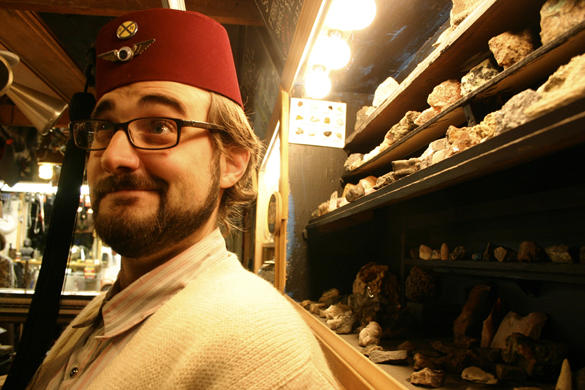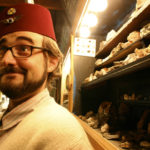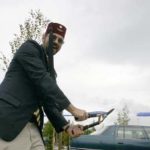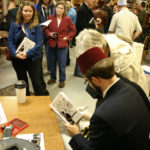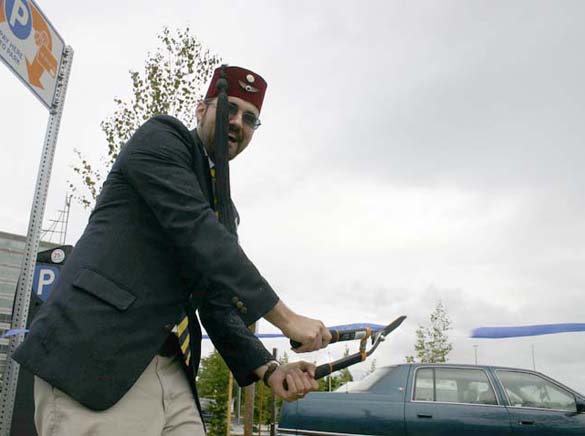BY THE TIME a wrecking crew arrived, it was too late. The hydraulic excavator, bulldozer, and backhoe sat like hungry monsters along Pacific Avenue and South 13th Street in downtown Tacoma, itching to turn the 119-year-old, six-story Luzon Building into a pile of broken bricks, splintered wood, and toxic dust. True, the building wasn’t much to look at. But that was because it was neglected for decades. Any historic preservationist would tell you the Luzon Building had a fine pedigree: designed by famed Chicago architecture firm Burnham & Root, it was one of the first “skyscrapers” on the West Coast, topping out at a soaring height for 1890s Tacoma.
But esteemed history wasn’t enough to save it. The City announced it would take emergency action to demolish the building. In the week leading up to its scheduled demolition, a dramatic, eleventh-hour meeting was held between historic preservationists and Tacoma City Manager Eric Anderson. In the end, the city stuck with its decision. The Luzon Building was a public safety issue. It could collapse on its own at any moment. At dawn on Saturday, September 26, 2009, the Luzon Building would have to come down.
If you were online the night before and looking for updates on the Luzon’s fate, you probably came across FeedTacoma.com and a post dated Sept. 25, 2009 at 9:40 p.m. by someone named R. R. Anderson: “LIVE BLOGGING: Demolition of Luzon FROM INSIDE! Sometimes one man can make a difference.”
Anderson wrote, “By the time the auto post feature makes this page live, I will be making my way to the Luzon. It is my intention to stop the destruction of this historical building by camping out inside on the top floor in a secret hiding place. I will post updates in the comment thread using my iPhone. I will camp out as long as it takes to melt the icicle heart of our City Manager Eric Anderson. I am a master of hiding. DO NOT TRY AND FIND ME.” He went on to list an inventory of items he had brought with him: rope, sleeping bag (black), two peanut butter and jelly sandwiches, respirator, black stocking cap, pry bar, canteen of water, first-aid kit, flash light (with red lens), adult diapers, duct tape, small tent (for decoy), and wireless internet connection.
“I figure as long as I’m in the Luzon, they can’t demolish it,” Anderson added. “Hopefully I’ll buy the preservation guys some time to change Mr. Anderson’s mind.”
If you know Anderson, 31, you know he is part performance artist, part political cartoonist, and part provocateur. The iconoclast is the master of a strange, funny, and often perverted world where he says and does things that many Tacomans only wish they had the nerve to do themselves. That said, was it really that far-fetched for Anderson to climb up inside the Luzon Building on the eve of its demolition and camp out?
The phone at Anderson’s Central Tacoma home began to ring. Messages were left on his answering machine. “The cops are on the scene,” one reporter from The News Tribune said in a message. “I suspect this is a hoax. But if it isn’t and you’re up there, give me a call.” A few minutes later, there was another phone call from a friend: “I’m at the Luzon! Get your ass out of there now!” Yet another person called to say, “Oh, my God! I’m calling 911 right now!”
Online, 81 comments on Anderson’s original post ranged from the amused (“Good luck! Signal to us when you get in. We’ll send someone to throw food up to you.”) to the concerned (“OK, R. R. The building is unsafe. This is not some kind of joke. They are going to start demolishing the building in six-and-a-half hours. Better get out of there now. You have made your point”).
Anderson provided updates online. He said he eluded two rent-a-cops and slipped inside the building (“Typical noob mistake. City forgot to weld manhole covers shut. See you in the basement”). Working his way up the building, he observed “nice vaulted ceilings” and “quite the spectacle going on outside.” But as Anderson added more updates, it became clear this was another one of his pranks. He entered a room “in excellent shape” with a faint glow from a gas lamp. A phonograph record was nearby (“spring on phonograph appears to be freshly wound. Dare I play the wax cylinder? This isn’t right. Building supposed to be abandoned. Why room look so lived in?!!!!!! clock on mantle just!!!!! chimed!!! Freaked out. Leaving room”). Continuing on, he met “a semi-transparent elevator attendant who said I had no business in the Luzon.” Finally, at 9:00 a.m. Saturday morning, after reaching the roof, camping overnight in his sleeping bag, and supposedly running out of adult diapers, he took his final action: “Time to deploy protest banner. World will know my story . . . ALL THESE WORLDS ARE YOURS EXCEPT EUROPA. ATTEMPT NO LANDINGS THERE. Damn. Wrong protest drop banner! You know what? Screw the Luzon. I’m going home.”
IF YOU FOLLOW local politics, you are familiar with Richard Ryan Anderson, the self-titled ‘DIY Cultural Arts Specialist.’ His ‘Tacomic’ political cartoons have appeared on FeedTacoma every Tuesday since March 2007. The cartoons even crossed over to mainstream print media when the Weekly Volcano reprinted them for nearly two years.
At times, Anderson’s Tacomics hit an issue square in the gut. In the ‘Luzon Tree Christmas Special’ Tacomic, Anderson cast the neglected and forlorn building — its roof crowned by a sparse tree holding a single ornament — as a thing of pity, reminiscent Charlie Brown’s Christmas Special (a caption reads: “I never thought it was such a bad little tree. It’s not bad at all, really. Maybe it just needs a little love”).
In another Tacomic, the rooftop of the vacated Russell Investments headquarters building is outfitted with a neon ‘SLIM JIM’S BAIL BONDS’ sign on its roof. The message: now that Russell has moved to Seattle after nearly 75 years in Tacoma, the real flagship industry in town (all the bail bond offices that front the streets around the Pierce County jail) can finally get their rightful attention.
Finally, another Tacomic shows former Tacoma City Councilmember Mike Lonergan, who, after failing to earn the Republican party’s endorsement for Pierce County Executive in 2008, formed his own political party and named it ‘Executive Excellence.’ In the Tacomic, Lonergan is a short and shriveled man wearing an old suit and thick glasses. He’s seated at a massive and empty table. An ‘Executive Excellence’ banner hangs above him, a few balloons are tied to empty chairs, and a record player sits in the back. A small note in the lower left corner of the Tacomic reads, ‘The Sad Party.’
Other times, Anderson’s Tacomics make you want to wipe your computer screen with a sterile cloth.
One example of this is a Tacomic that shows former Tacoma Schools Superintendent Charlie Milligan, who was fired by the school board, but not before receiving a sizable severance package. He is shown on all fours, without pants, and smiling as dump trunks unload endless wads of cash in his rear end.
Anderson’s antics aren’t limited to pencil and paper. Last year, he was one of nearly four-dozen people who applied for an open seat on Tacoma City Council. During his three-minute candidate statement at City Hall and in front of the TV Tacoma cameras, he promised to designate the Tacoma Dome as a hazard to life and liberty, introduce a local currency, and reduce crime by 200 per cent. “Why do I want this job?” he asked rhetorically in front of the full council. “How hard is it to sit up there and vote unanimously on everything?”
On Nov. 15, King’s Books in Tacoma will host a reading and book signing for Anderson, who was one of 17 artists to receive a grant last year through the city’s Tacoma Artists Initiative Program (TAIP). Anderson used the $2,500 award to produce a book of Tacomics entitled “100 Tacomics: The Secular and Apolitical Cartoon Life of Tacoma and her Moral People(s), Vol. 001” (Full Disclosure: I edited Anderson’s book for free. Over the years, I have purchased two of his original Tacomics; a third was given to me as a gift. I have also been depicted in a few of his Tacomics). The book is more than just a collection of Tacomics that have already appeared free on the Web or in print. It is a “behind-the-scenes” account of how the sausage gets made. It includes photographs, bonus sketches, and a foreword by The New Takhoman publisher John Hathaway.
“I’m honored every time I’m in his Tacomics,” says Tacoma City Councilmember Marty Campbell. “I’m not always happy about it, but I’m honored. He gets some attention at City Hall. You have to take what he does in stride with other feedback from the community. I can’t say there’s ever been a stop-the-presses kind of day at City Hall because of his Tacomics. At the same time, I wouldn’t say his commentary is dismissed. It’s looked at as feedback from the community — maybe a little caustic at times.”
“R. R. is not afraid to go anywhere,” says cartoonist Elliot Trotter. The former Tacoma resident now lives in Seattle, but continues to follow and admire Anderson’s work. “I am constantly intrigued by his willingness to step beyond our notions of his limits . . . [H]e does not draw things just to shock people, but instead seeks the best communicative device to show the world why he’s right. Personally, I’ve been bitten by R. R.’s work one too many times to be offended or shocked, but even as a resident of Seattle, I’m far too addicted to the poison to not continue to seek it.”
STILL, WITH CITY Hall a frequent target of Anderson’s Tacomics and pranks, it stunned people who knew him when he announced online the City awarded him a TAIP grant.
“I’m sure [Tacoma Arts Administrator] Amy McBride kind of held the barbecue tongs on my application and passed it on to other people,” Anderson told me recently over tea at Mad Hat in downtown Tacoma. “I think it will hopefully stir up some controversy. Part of me suspects I’m kind of sneaking through the cracks.”
When I asked McBride about this, her comments were guarded and boilerplate. “The panel, when it reviews the work, it reviews it on the quality of the work before them,” she told me. “It’s not that usual for government agencies to fund individual artists because of the fear of what individual artists will do. I’m really proud the panel supports new work and isn’t afraid of potential controversy. They just take into account the strength of the work.” At one point, she wandered off-script enough to recall meeting Anderson at City Hall shortly after he received the $2,500 award. “When he was up here, I said, ‘Mr. Anderson, welcome to the establishment. Here you are in the belly of the beast,'” she said, laughing.
Anderson, who wears thick black glasses, is awkwardly tall and gangly. He has a coarse brown goatee that grows out along his jaw lines and connects to his thick sideburns. I’ve interviewed Anderson three times in the past three years and he has always proved to be a difficult subject. It’s not that he’s the noisy and frantic mess you would expect. He’s just the opposite. Anderson can be downright mute. Questions about how he comes up with his ideas or what he thinks about the attention Tacomics have received over the years are usually answered in one or two sentences. He isn’t rude or arrogant, just painfully shy.
Before our meeting at Mad Hat, I was hoping for a little more insight, so I e-mailed some topics I hoped to cover in our interview. I asked him if he saw any similarities between Tacoma and Juneau, where he was raised, and whether he could do an equivalent of the Tacomic in his hometown.
“Tacoma kind of reminds me of Juneau in a lot of respects,” he said slowly and in his near-whisper voice. “Especially downtown because it’s isolated. Juneau is a very liberal stronghold in a very conservative red state. It’s kind of like Tacoma in that there are parts that are very liberal and the rest of Pierce County is very conservative for the most part. Tacoma was a good opportunity [for me to do Tacomics] because there were so few other people doing that kind of thing.”
For Anderson, living in Tacoma — with its history of scandals (a murder-suicide at the hands of former Tacoma Police Chief David Brame) and boneheaded decisions by city leaders (installing parking pay stations downtown during an economic recession and when the area’s biggest employer just fled to Seattle), and small size (for years, city leaders have challenged Spokane in a contest nobody really cares about over who holds the title of second largest city in Washington State) — makes it easy to come up with a new Tacomic every week.
“There is always something going on,” he said. “Tacoma is big enough, but not too big, like Seattle, where your voice would get drowned out. It’s the Goldilocks planet. It is really weird. The weirdness just kind of snowballs sometimes.” The Tacomic is a way for him to vent frustration over a city that, he says, is dear to him. “I care deeply about Tacoma. My anger is pretty genuine. Some of the stuff drives me crazy. If I didn’t care, I wouldn’t be drawing these things. I would be doing something else.”
Councilmember Campbell thinks Anderson isn’t just kicking Tacoma around out of some cruel satisfaction. “I think he’s good for Tacoma,” says Campbell, who also owns Buzzard’s Discs and Stadium Video. He has been a frequent target for Anderson and has even purchased some of Anderson’s work. In one animated GIF that made the rounds online, Campbell, who went from the somewhat scrappy and bearded owner of a used record store to a clean-cut politician when he ran for City Council, is shown with the alternating facial hair of recognizable icons (Charlie Chaplin, Salvador Dali, Frank Zappa, Abraham Lincoln) complements of Anderson. “My mom loved it,” recalls Campbell. In a Tacomic entitled ‘The Little Engine That Couldn’t,’ Campbell’s face appears on the front of a derailed locomotive. It was published in 2008, shortly after he was defeated in his first run for Tacoma City Council. “On one hand, it was horrifying,” Campbell told me. “On the other hand, he so earned my respect that I passed it around to friends.”
Campbell isn’t the only public figure who has contacted Anderson about purchasing original Tacomics. According to Anderson, a Tacomic depicting Pierce County Assessor Dale Washam riding a giant bullet like a surfboard and wielding a crucifix was purchased by one of Washam’s relatives. A Tacomic about disgraced former Pierce County Superior Court Judge Michael Hecht was also purchased. “The police detective who hauled in Judge Hecht, his partner bought that cartoon from me, along with a cartoon some guy in Seattle drew, framed them, and gave them to the detective as kind of a pat on the back,” said Anderson. Last month, Anderson exchanged a Tacomic featuring Pierce County Prosecutor Mark Lindquist for a signed copy of one of Lindquist’s novels, according to Anderson.
Campbell says Anderson brings attention to a lot of issues that would generally fly under the radar. “One of the things I really appreciate about R. R. is that he’s equal opportunity,” says Campbell. “If you stumble, he’ll be right there with his pen. At the same time, he will help bring you up. I think he’s really trying to help make the community a better place through his art by either raising unseen or smaller issues, or just disseminating information in a different style.”
Not everyone is a fan.
One Tacomic published on Sept. 11, 2007, showed a commercial airplane crashing into the Winthrop Hotel near Broadway. It was published shortly after two City employees were fired — one for mismanaging the Broadway Local Improvement District project, which led to harsh criticism of City Hall. “This comic is in horrible taste,” wrote one commenter. “I’m disgusted that it was posted.” Another commenter wrote, “I’m not really surprised that it was posted. I guess I just don’t really see the comparison between a national tragedy that is still a pretty raw wound for a lot of people and the Tacoma City Council / Broadway LID stupidity going on. I think posting it on 9/11 is pretty distasteful.”
He has butted heads with City Hall staff who manage the Tacoma Art listserv. At one point, according to Anderson, his posts needed to be approved by a moderator before they were made public. Later, his e-mail address was deleted from the listserv after some people were offended by his messages. “If anything I’ve ever sent through the service was considered by some to be offensive, I am just as much a victim,” Anderson told me. And when his Tacomics ran in the Weekly Volcano, three were pulled prior to publication due to content deemed too risque. One Tacomic showed a Tacoma police officer and a Ku Klux Klan member high-fiving outside the Pantages Theater after a hip-hop show was canceled. “The Weekly Volcano did pull R. R. Anderson’s comic this week,” wrote co-publisher Ron Swarner at the time. “I felt the Tacoma Police Department high-fiving a Klan member was extreme and unwarranted. It didn’t sit right with me.”
Anderson doesn’t apologize.
“I’m a traditional cartoonist,” he explained. “I think cartoons should be the most exaggerated possible. If you can make it even more exaggerated, that’s the cartoon you should have drawn. The Tacomic is about extreme exaggeration and hyperbole, [and going] over the top.”
A FEW WEEKS later, I met Anderson in the Theater District after work and we drove to his Tacoma home. Anderson’s wife, Darcy, 32, a thin, small-boned woman with straight brown hair, outsized laugh, and refreshing earthiness, is a preschool teacher and artist in her own right. The couple has a blonde-haired, energetic three-year-old son, Max, and live in a small but comfortable home just off busy 19th Street. You know it’s an artist’s home when you step up to the front gate: a robot scarecrow stands in the yard (one of R. R. Anderson’s creations) and his old, green Mercury Tracer is parked in front (its front end has been fitted with what appear to be shark’s teeth).
Inside their home, Max could be heard giggling in a room down the hall as he watched an episode of Curious George on a television set. One of R. R. Anderson’s early works hung in the living room: a giant oil-on-canvas, Warhol-esque painting of pop singer Gwen Stefani. In their tidy kitchen painted baby blue and filled with shiny white appliances, a chalkboard listing some of the tasks that needed to be done hung from the adjacent laundry room door: Darcy needed to work on her hand-stitched cupcakes; R. R. needed to tidy his backyard studio in preparation for this month’s Art At Work studio tours. In fact, the couple has two backyard studios. It’s part of what R. R. describes as the Holistic Forge Works Campus: their home is the ‘corporate safe house’; R. R.’s studio is the ‘American Museum of Alaskan Entrepreneurship’; and Darcy’s studio is the ‘Cupcake Atelier.’ R. R.’s studio is a small shed that has been converted into a low-lit room chock full of bizarre inventions, heavy machinery, and illustrations created by Anderson: framed pockets of corduroy pants and heavy work shirts; haunted yard tools; the Experience Typewriter Project; a cursed anvil; a cardboard octopus ‘preserved’ in a jar; a ‘mystery vortex’; and the Atomic Tacomic Gallery that displays a collection of framed Tacomics.
“Everything about his studio is maleness, tools, gadgets, gizmos and crazy contraptions,” said Darcy during a tour of their separate studios. “I thought it would be funny if I was just the complete opposite of that. It’s kind of set up like this totally femme, french cafe studio.” Open a pink door to Darcy’s cheery studio and you will find two of her oil-on-brown-paper portraits clipped to an easel. They show Darcy and R. R. dressed in the formal dress of an older couple, say, headed for church in a small farming town. Darcy wears a light, coral-green cotton dress; R. R. wears glasses, a suit coat, tie, and collared shirt. His beard is groomed and his hair is neatly combed, most of it tucked beneath a red fez. It’s all washed in a sepia tone that makes the paintings seem more like old heirlooms discovered in a family attic.
R. R. and Darcy have known each other since grade school. They with their families in Juneau. They were classmates through high school. They belonged to the same high school art club, but never dated. “I have this funny photo from our senior class trip together with our art club,” Darcy told me. “There’s a picture of us in San Francisco. Here we are a bunch of Alaska kids in the big city and we’re all posing. And then there’s Ryan off in the background kind of this — I don’t know — this guy! We didn’t really pay much attention to him. He was kind of invisible. He always had that — “
“Ninja-like quality,” Anderson interrupted.
Darcy let out a booming laugh. “Yeah. Ninja-like quality,” she said sarcastically. “He was just always kind of there. His art was amazing, so we respected him for that. But it was like, alright, who is this Ryan kid?”
After high school, Darcy and R. R. went their separate ways. Darcy moved to Vancouver, B.C. to attend the Emily Carr Institute and earn a Bachelor of Fine Arts. R. R. moved to Sunnyvale, Calif., to attend Cogswell Technical College and major in computer animation. Eventually, Darcy moved to Lake Stevens, Wash., to live with her family, who had relocated from Juneau. R. R. settled in Tacoma in 2001, and worked as a ramping agent for Horizon Airlines at Sea-Tac Airport until he was hired as a Web designer and graphic artist for Artifex in downtown Tacoma. In 2004, Darcy was online and searching for former classmates in her high school art club. She found R. R. They exchanged e-mails and agreed to meet at the Space Needle for a beer and to hang out.
“That’s when you started cyber-stalking me,” R. R. interjected. At this point, Curious George is over and Max is playing with his dad’s beard and squirming around in his lap.
“He shocked me,” recalled Darcy. “He was funny. That kind of made me think that he’s not this quiet, nerdy guy after all. Maybe he has this dark, funny quality — which I found to be very true.” Darcy moved to Tacoma in 2005 to be closer to Anderson. They married a year later, and Max was born in 2007.
At first, Darcy ignored Anderson’s Tacomics. They were just silly drawings he posted online. It wasn’t until 2008, when the Tacomics were published in the Weekly Volcano, that she paid attention. “I thought that was really cool because then it was more visible to people that I knew who read the Volcano.” When Helm Art Gallery in downtown Tacoma presented Anderson’s work in 2008, Darcy realized Anderson was onto something. The gallery was filled with people and Anderson sold a lot of his work. “I was like, ‘Wow, look at all of these people.'”
The art show motivated Anderson to apply for the TAIP grant. When a letter from the Tacoma Arts Commission arrived, Darcy plucked it from a stack of mail. “I thought it was going to say, ‘Sorry to inform you Ryan Anderson that there is no money for you,'” she told me. “But it was like, ‘Congratulations!’ No way! That’s when I realized, OK, people are taking him seriously if they are giving him money. And it was a pretty legitimate amount of money considering funding decreases and a lot of arts commissions not having anything.”
Still, the Tacomics make Darcy uneasy. R. R. usually works late into the night on Monday — and even into early Tuesday morning — on the week’s Tacomic, which is online by 7 a.m. As Darcy and Max sleep in other rooms, Anderson is awake in his office and working under a desk lamp with pencil and paper. If she wakes up in the night to check on R. R., she usually steers clear of whatever he’s working on. “Most of the time I just have this kind of sensor about myself. If I do look, I think, ‘Oh, what are you getting yourself into?’ I think sometimes he can be a big bully. I think that’s what a political cartoonist is.” Darcy turned toward R. R. “But you can be. You will take these people and the way you twist things around.”
“I’m a freedom fighter,” Anderson protested.
“A freedom fighter,” Darcy sighed, rolling her eyes. “I don’t know. I think sometimes I act as that little whispering voice on the shoulder, where I’m like, ‘I don’t know about that. That might get you into trouble. You need to be a little more sensitive with these issues.’ Sometimes he listens and sometimes he doesn’t.”
For Darcy and others who know or meet Anderson in-person, it’s almost as if Anderson has a split personality.
“He’s got this dual thing that he does,” she explained. “He’s quiet and reserved, but constantly observing and constantly sucking in every little detail around him. Then he goes and his mind works and he just blasts it out there on the Internet because he thinks it’s cool because nobody is really listening to him, right? But everyone is listening. I don’t know. Sometimes I just go, ‘Who is this guy?’ I kind of take a little bit of a step back because that’s not really the guy I know who I sit down and eat dinner with or have a kid with.”
ON OCTOBER 18, Anderson announced to the 412 people who follow him on Twitter that 200 copies of his book would be in Tacoma in 13 days. Eleven days later, he posted: “240 pounds of Tacomic Books are in Utah en route to Tacoma RIGHT NOW!” and “That’s six 43-pound boxes of Tacomic Books!” The tweets were part of an effort to build excitement for the book. He auctioned off the original manuscript as a fund-raiser for the Cartoonist League of Absurd Washingtonians (C.L.A.W.), of which he is a founding member (the group dons fez hats and meets regularly for late-night cartooning sessions). The money raised will go toward a grant awarded annually by C.L.A.W. to an aspiring local cartoonist. When a single copy of the book arrived at the Anderson home ahead of the full shipment, Anderson tweeted: “Ms. Darcy reports: ‘YOUR BOOK HAS ARRIVED!'” He also posted photos of Max wearing a paper crown and holding up the book. Last week, he met with Tacoma Public Library officials and they agreed to keep three copies of the book in the archives of the Northwest Room. Anderson was elated.
At one point during our interview at Mad Hat, I asked him what he hoped to achieve with his book.
“I would like when I’m dead and gone there be some kind of record of me, even if it’s just Tacoma in political cartoons from 2007 to 2009,” he told me. “Give people in the future some kind of weird window into how strange Tacoma can be.” He paused, then added, “I would like to do Tacomics forever. Like Charlie Brown. Like Chuck Schultz. Dying in my boots in front of the drawing table.”
To read the Tacoma Daily Index‘s complete and comprehensive coverage of R. R. Anderson, click on the following links:
- Downtown Tacoma’s Tinkertopia grand opening July 20 (Tacoma Daily Index, July 16, 2013)
- Fund-raising success for Tacoma playing card project (Tacoma Daily Index, July 18, 2012)
- Tacoma chalk artists have their day (Tacoma Daily Index, April 6, 2012)
- Amocat Cafe to host R. R. Anderson ‘Tacomic’ art show in March (Tacoma Daily Index, February 2, 2012)
- A political cartoonist ‘celebrates’ downtown’s latest development — another parking lot (Tacoma Daily Index, July 13, 2011)
- Year In Review — Cartoonist R. R. Anderson (Tacoma Daily Index, December 29, 2010)
- A creatively fun night with R. R. Anderson at King’s Books (Tacoma Daily Index, November 16, 2010)
- Mightier Than Swords: Tacoma artists zero their pens on local politics (Tacoma Daily Index, March 21, 2007)
Todd Matthews is editor of the Tacoma Daily Index and recipient of an award for Outstanding Achievement in Media from the Washington State Department of Archaeology and Historic Preservation for his work covering historic preservation in Tacoma and Pierce County. He has earned four awards from the Society of Professional Journalists, including third-place honors for his feature article about the University of Washington’s Innocence Project; first-place honors for his feature article about Seattle’s bike messengers; third-place honors for his feature interview with Prison Legal News founder Paul Wright; and second-place honors for his feature article about whistle-blowers in Washington State. His work has also appeared in All About Jazz, City Arts Tacoma, Earshot Jazz, Homeland Security Today, Jazz Steps, Journal of the San Juans, Lynnwood-Mountlake Terrace Enterprise, Prison Legal News, Rain Taxi, Real Change, Seattle Business Monthly, Seattle magazine, Tablet, Washington CEO, Washington Law & Politics, and Washington Free Press. He is a graduate of the University of Washington and holds a bachelor’s degree in communications. His journalism is collected online at wahmee.com.
